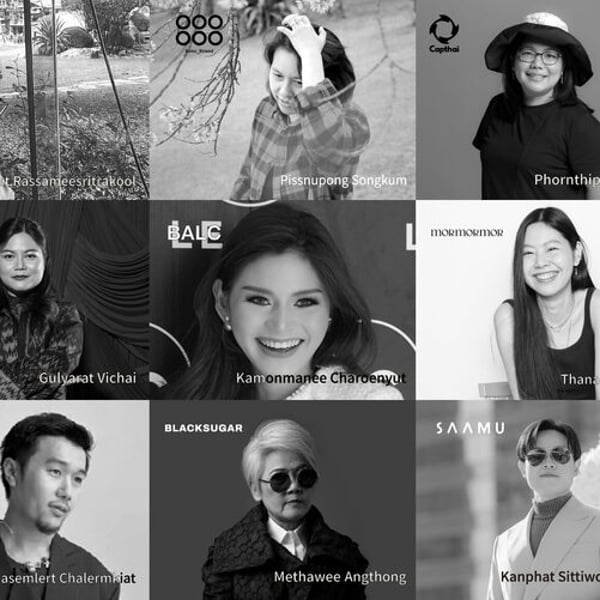Fashion
From Bangkok to Xiamen: Thai designers’ collective debut redefines Asia’s aesthetic discourse through strategic partnership

Published
November 1, 2025
The project, themed “From Bangkok to Xiamen,” launched a collective debut for Thai designers during this year’s Xiamen International Fashion Week (XMIFW) , which signifies the city’s ambition to be an International Consumption Center City.
Xiamen’s unique assets—including its overseas Chinese heritage, open commercial culture, and consumer influence across Southern China—have created the essential groundwork for international emerging brands to efficiently enter the Chinese market.
From October 16 to 19, XMIFW successfully hosted this major trilateral initiative that featured four key components: a pop-up store showcasing Thai designers, an industry workshop for China-Thailand fashion collaboration, and the Chinese debut runway show for the Thai brand BlackSugar.
The backbone supporting XMIFW’s presenting this project is its decade-long commitment to building an “industrial interface” capability. The system is founded on the long-term operation of the “Ru Shi” (入时) designer platform and the “How How Hub” (好好市场) physical space. It integrates multi-dimensional resources, including top-tier brand collaborations, endorsement from authoritative media, and high-end industry forums, collectively forming a complete commercial value chain.
Crucially, the event was cemented by the official signing of a memorandum of understnding between the fashion week organizer, FN China, and Qurated Company, an authoritative and internationally influential fashion industry incubation project initiated by Department of International Trade Promotion (DITP)., Ministry of Commerce, Thailand. As a direct result, Xiamen and Bangkok will act as essential partnership hubs for accessing each other’s fashion markets, leveraging their resources to intensify engagement among all fashion stakeholders, from designers to consumers, and ensuring mutual benefit through cultural appreciation and joint business creation.
“Xiamen holds a unique three-dimensional strategic value for Thai brands entering the Chinese market: Platform Empowerment, Market Validation, and Regional Radiation,” said Lin Ru, secretary-general of Xiamen International Fashion Week.
“Xiamen’s distinctive culture fosters a high degree of acceptance for creative Thai designs. Crucially, our comprehensive and advanced fashion supply chain fully empowers Thai brands by consolidating media, channels, and resources to facilitate everything from display and market testing to commercial realization. Based here, brands are also strategically positioned to efficiently radiate to key consumer hubs in China.”
Thai designer platform director Dr. Anothai Cholachatpinyo explains that Qurated’s edge is its commitment to “real market validation.”
Brands are tested for commercial viability in top local retail environments like IconCraft and Style Bangkok before they are successfully propelled onto international platforms, including Tokyo Jumble, Paris Who’s Next, and New York Fashion Week. And he also indicated that Qurated is not merely an incubator; it’s a “globally recognized launching pad.” It systematically prepares Thai brands for the world stage by blending design innovation with sharp business strategy.
Thai fashion design is rapidly advancing from a regional force to a new voice that the global community cannot ignore. Simultaneously, Thai celebrities have unequivocally emerged as an influential power in the international fashion scene. The luxury sector has fully embraced this shift, recognizing the stars documented power of persuasion and their expansive reach into new audiences.
Consequently, major fashion houses like Prada, Louis Vuitton, and Gucci are actively appointing well-known Thai figures as brand ambassadors, a move that significantly boosts the international prominence and visibility of Thai fashion.
The 11 Thai brands made their first entry into the Xiamen consumer market at the pop-up store located in ‘HOW HOW HUB’ on Zhongshan Road, with brand acceptance among local trendsetters proving to be much higher than predicted.
A China-Thailand Fashion Industry Seminar was also held, where both sides engaged in in-depth discussions on topics such as design innovation and supply chain collaboration. The conference showcased concepts for sustainable cooperation, including establishing a ‘Thai Designers Xiamen Exchange Center’ and transitioning ‘pop-up stores to permanent residency,’ reaching exciting consensus on mechanisms like two-way mutual visits and brand mutual assistance.
Moving forward, XMIFW is positioned to offer any international brand seeking entry into the Chinese market a comprehensive solution that systematically elevates its visibility, professional credibility, and commercial potential. This includes providing emerging brands with a “Minimum Viable Test” (MVT) loop—a closed system that spans everything from immediate sales and direct consumer feedback to supply chain resource matching. For market newcomers, the core value of this system lies in significantly lowering the entry barrier and reducing trial-and-error costs.
And finally, just before the 11 designers returned to Thailand, FashionNetwork.com secured the opportunity to speak with them directly to hear their immediate reflections on the experience.
FashionNetwork.com: Since this marks your first showcase here, what are your initial thoughts on the Xiamen/Chinese market? What specific expectations or goals do you have for entering the Chinese consumer space?
Balc: We expect to rapidly build brand loyalty by directly catering to the needs of our target customers and transforming our sincere hope for expansion into a tangible reality.
Big Foot: We’d like to have a deeper understanding of Chinese consumers —their needs, preferences, and lifestyle inspirations — which will guide us in developing products and experiences that truly resonate with.
BlackSugar: We see great potential in the Chinese market the scale, the curiosity, and the openness to new aesthetics. After completing the show, it gave us a strong sense of confidence. The warm response from the audience encouraged us to refine some details in our design and presentation to better connect with Chinese consumers while staying true to the BlackSugar identity.
Bono Brand: We hope to connect with conscious consumers who value craftsmanship, honesty, and sustainability, to build long-term collaborations with local partners who share the same vision for a better and more responsible world.
Capthai: We believe that to enter a new market, we must act local — to understand people’s lifestyle, fashion sense, and what truly inspires them. We’re here to learn, connect, and share our story with this inspiring city.
Collector Project: With the vibrant atmosphere, I believe my creations will be well received by the Xiamen audience and open new opportunities within this distinctive market.
Maison Wonder Anatomie: For this showcase, I hope to present a collection that reflects Thai culture, and I wish it will appeal to Chinese customers, creating more opportunities for business and helping us expand our market to reach a wider target audience.
Homrak: The Chinese market has long been known for its appreciation of craftsmanship and meaningful design. I believe these values resonate strongly with the Chinese sense of harmony authenticity and appreciation for craftsmanship. I hope this opportunity will open a path for creative exchange cultural dialogue and mutual learning between Thailand and China.
Mormormor: We’re looking to gradually explore the Chinese market and hope to build brand recognition so that people can identify our designs as uniquely ours. We’re also interested in trying out online sales through local platforms.
Mujil: Our goal in entering the Chinese market is to connect with consumers who value craftsmanship, authenticity, and meaningful stories behind what they wear or use. We look forward to meaningful exchanges — both B2B and B2C — and to exploring partnerships with Chinese designers, retailers, and cultural spaces to bridge our cultures through creativity and craftsmanship.
Saamu: We see the Chinese market as very sophisticated, people here love design that has soul. Saamu’s story of Thai craftsmanship and culture fits beautifully with that mindset. We aim to build cultural connection, not just commerce.
Copyright © 2025 FashionNetwork.com All rights reserved.
Fashion
US brand Vera Bradley posts net revenue of $62.3 million in Q3

Vera Bradley reported Q3 net revenues of $62.3 million, down from $70.5 million year over year.
Direct revenues fell 5.3 per cent, with comparable sales down 5.8 per cent, while indirect revenues dropped 30.2 per cent.
Gross margin declined to 42.1 per cent, impacted by inventory write-downs and higher duties, despite early progress from its Project Sunshine transformation.
Source link
Fashion
Community is fashion’s new competitive currency across the value chain
Fashion
Canada’s Roots posts 6.8% sales growth in Q3 FY25 on strong DTC demand

The direct-to-consumer (DTC) sales increased 4.8 per cent to $56.8 million, driven by comparable sales growth of 6.3 per cent, reflecting enhancements to the omnichannel customer experience and stronger engagement with curated product assortments.
Canadian outdoor lifestyle brand Roots has reported solid Q3 FY25 results, with sales rising 6.8 per cent to $71.5 million, driven by DTC growth and stronger wholesale demand.
Gross margin improved to 60.8 per cent, while Adjusted EBITDA increased 5.3 per cent to $7.5 million.
Net income stood at $2.3 million, and net debt declined 5.9 per cent, reflecting disciplined execution.
The gross profit of the company increased 8.1 per cent to $43.4 million, while gross margin improved by 80 basis points (bps) to 60.8 per cent. DTC gross margin rose 140 bps to 65.4 per cent, benefiting from improved product costing and lower discounting, which offset unfavourable foreign exchange impacts on US dollar purchases, Roots said in a press release.
Partners & Other (P&O) sales grew 15.3 per cent to $14.6 million, supported by earlier wholesale orders from Roots’ operating partner in Taiwan for upcoming holiday and spring seasons, along with higher domestic wholesale sales of custom Roots-branded products.
Selling, general and administrative (SG&A) expenses increased 10.6 per cent to $38.2 million, largely due to higher variable costs linked to sales growth, strategic investments in marketing and personnel, incremental US duties on e-commerce sales, and higher share-based compensation expenses.
The net income stood at $2.3 million, or $0.06 per share during the period under review, compared with $2.4 million a year earlier. Excluding the impact of revaluation of cash-settled instruments under the share-based compensation plan, net income would have been $2.4 million, representing a 1.5 per cent improvement YoY. Adjusted EBITDA rose 5.3 per cent to $7.5 million, or 7.3 per cent on an adjusted basis excluding revaluation impacts.
“Roots delivered strong third-quarter results, with growth driven by consumers’ positive response to our products, enhanced marketing efforts, and improved in-store execution,” said Meghan Roach, president and chief executive officer (CEO) of Roots Corporation. “Even in a dynamic retail environment, our heritage, quality, and focus on comfort continued to differentiate the brand and drive engagement across our omnichannel platform. We remain disciplined in execution and committed to strengthening the foundations of the brand to support long-term value creation. While early in the fourth quarter, we continue to experience positive trends.”
“Our disciplined approach to investing in strategic growth continues to deliver results,” said Leon Wu, chief financial officer (CFO) at Roots. “We have sustained positive sales momentum and maintained the underlying margins of those sales, supporting a stronger balance sheet with year-over-year reductions in net debt.”
Net debt declined 5.9 per cent YoY to $44.1 million, while the company also repurchased 415,200 common shares for $1.3 million under its normal course issuer bid.
For the first nine months of FY25, total sales increased 6.6 per cent to $162.2 million, with DTC sales rising 8.6 per cent and comparable sales growth reaching 11.5 per cent. The gross margin expanded to 60.9 per cent, while net loss narrowed to $10 million from $11.7 million a year earlier. Adjusted EBITDA improved to a loss of $1.7 million, reflecting continued progress towards profitability.
At the end of Q3 FY25, inventory stood at $66.6 million, reflecting preparations for peak holiday demand and higher in-transit stock. Free cash flow improved to a loss of $4.6 million, while total liquidity amounted to $34.5 million, providing financial flexibility heading into the final quarter.
Fibre2Fashion News Desk (SG)
-

 Business6 days ago
Business6 days agoHitting The ‘High Notes’ In Ties: Nepal Set To Lift Ban On Indian Bills Above ₹100
-

 Politics1 week ago
Politics1 week agoTrump launches gold card programme for expedited visas with a $1m price tag
-

 Business1 week ago
Business1 week agoRivian turns to AI, autonomy to woo investors as EV sales stall
-

 Fashion1 week ago
Fashion1 week agoTommy Hilfiger appoints Sergio Pérez as global menswear ambassador
-

 Sports1 week ago
Sports1 week agoPolice detain Michigan head football coach Sherrone Moore after firing, salacious details emerge: report
-

 Business1 week ago
Business1 week agoCoca-Cola taps COO Henrique Braun to replace James Quincey as CEO in 2026
-

 Tech1 week ago
Tech1 week agoGoogle DeepMind partners with UK government to deliver AI | Computer Weekly
-

 Sports1 week ago
Sports1 week agoU.S. House passes bill to combat stadium drones



















